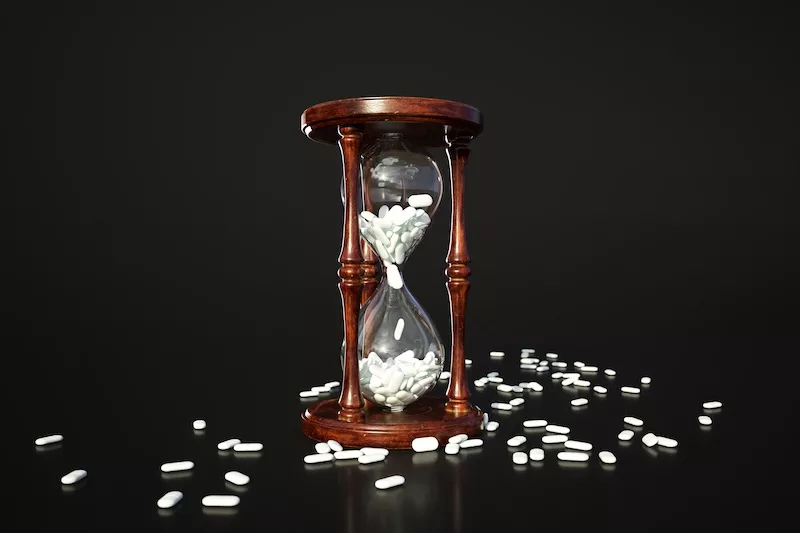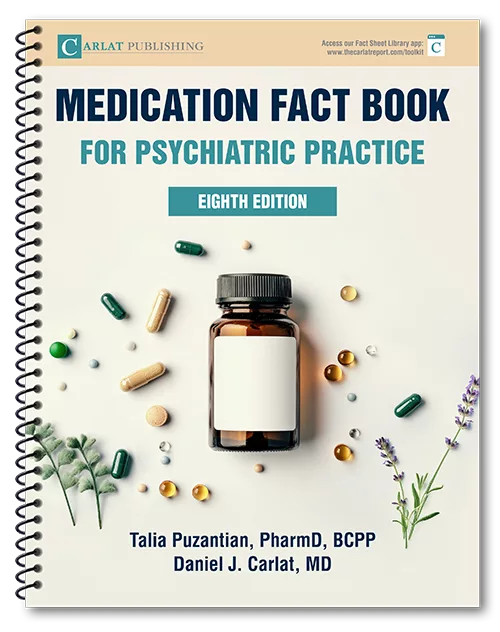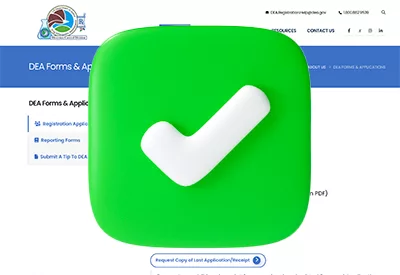Sometimes we have a window of opportunity to make a difference. In this series we discuss time-frames where panic, clozapine, and metformin have the greatest benefits.
Publication Date: 02/24/2025
Duration: 11 minutes, 53 seconds
Transcript:
KELLIE NEWSOME: Clozapine is the most effective medication we have for schizophrenia. But how well it works depends on when you start it. Welcome to the Carlat Psychiatry Podcast, keeping psychiatry honest since 2003.
CHRIS AIKEN: I’m Chris Aiken, the editor-in-chief of the Carlat Report.
KELLIE NEWSOME: And I’m Kellie Newsome, a psychiatric NP and a dedicated reader of every issue. Last month we went to the Rapid Acting Mental Health Treatment conference in San Francisco with Owen Muir and Carlene MacMillan who run the always fun and often cutting-edge Frontier Psychiatrist blog. The conference featured new technologies that aim to treat and detect mental illness faster. There was NightWare – an app that uses the Apple Watch to nudge people out of the dream state if they start having nightmares, cleared by the FDA in 2020. TDScreen, an app that uses a smartphone camera to detect tardive dyskinesia. And even one that is making clinicians’ lives easier – including my own – MDHub uses Artificial Intelligence to write your clinical notes for you by making a HIPPA-compliant recording during the session. And then there was Dr. Aiken, who didn’t have a product to pitch but was there to remind everyone that… when it comes to mental health interventions, timing is everything.
CHRIS AIKEN: Some of our listeners asked for a recording of the talk I gave there, and we don’t have one, but I’ve turned it into this podcast series. Today you’re going to learn how timing matters with one of the most powerful treatments in our armamentarium: Clozapine.
KELLIE NEWSOME: Experts may disagree on which antipsychotic to start with in schizophrenia. Some like Risperdal or – outside the US – amisulpride, both of which have a large effect size. Some choose cariprazine for its possible benefits in negative symptoms. Some like olanzapine, which shines for its efficacy but not so much for its metabolic risks. Others use olanzapine second line and reach first for ones with a fewer metabolic risks, like lumateperone or Cobenfy, the new xanomeline and trospium combo pill that doesn’t block dopamine. But wherever you start, all experts agree on where you should end up if things don’t go well: Clozapine. Treatment guidelines tell us to move to clozapine after two failed antipsychotic trials in schizophrenia, where “failed” means they tolerated the drug enough to give it a therapeutic trial, and it didn’t make a meaningful difference in their positive psychotic symptoms. We may not expect a full recovery on an antipsychotic, but they should at least bring the patient to a functional level where they aren’t going to the hospital or causing frequent problems in the family because of psychotic behavior. That’s the spirit of the guidelines, but if you want technical details we got them. All these ideas have exact definitions.
- An “adequate trial” is 6 weeks at a therapeutic dose.
- A “therapeutic dose” is 400-600 mg chlorpromazine equivalents, so like 15-20 mg of aripiprazole, 4-6 mg of risperidone, 10-15 mg of olanzapine, or for those outside the use, amisulpride dosing is about the same as chlorpromazine so with that one a therapeutic dose would be 400-600.
- A “meaningful difference” is more than a 20% of reduction in psychotic symptoms.
CHRIS AIKEN: The guidelines are clear on this because the research is clear. Clozapine is the only drug that proved its efficacy in well-designed trials of treatment-resistant schizophrenia. A close second is high-dose olanzapine, like 25-50 mg a day. In 3 out of 4 small randomized controlled trials, high-dose olanzapine was equal to a switch to clozapine in treatment-resistant schizophrenia. Clozapine also has a few extra benefits that cause some guidelines to move it up to second line for specific populations like patients with problematic aggression or self-harm. Clozapine prevents suicide, violence, and is the only antipsychotic that doesn’t cause tardive dyskinesia.
KELLIE NEWSOME: That’s actually clozapine’s origin story. In the 1970’s tardive dyskinesia was becoming a big problem as psychiatrists turned to high doses of high-potency antipsychotics to try to help patients who weren’t responding. We’re talking like 10-20 times the usual dose of haloperidol. The attempt was well-meaning but ultimatelyfailed to do anything more than cause side effects like TD. And it was into this world that clozapine took its first steps. When clozapine was first released (in Europe in 1971) its main advantage was that it didn’t cause TD, but it soon got taken off the market because it caused another problem. 1 in 100 patients who took it developed potentially fatal neutropenia on the drug, causing most countries to voluntarily withdraw the drug a few years later. The drug never made it to the US in the 1970’s, but US researchers continued to investigate the drug and by 1988 they had convincing data that it didn’t just spare patients of TD. It helped people recover when other antipsychotics didn’t work.
CHRIS AIKEN: Now, if they were seeking approval for Depression or Panic Disorder, this would probably still be a no-go. But schizophrenia is a much more destructive and deadly illness, so the FDA took a risk on it and approved the drug in 1989 with tight restrictions, requiring weekly blood draws to prevent agranulocytosis. In 2005 they lowered that frequency, and the current REMS program requires weekly monitoring for the first 6 months, then every 2 weeks for the next 6 months, and then monthly as long as the ANC stays normal. This summer, an FDA committee voted to eliminate these requirements altogether, which might mean clinicians to be in charge of the monitoring much like we are for lithium. We’re still waiting for the final word on that. The decision was based on another window worth knowing: Remember that 1 in 100 patients develop serious neutropenia on clozapine? Well, nearly all of those cases occur within the first 4-5 months of starting the drug. The risk peaks of agranulocytosis is at 2-3 months of the drug, and after 2 years on the drug it is close to zero.
KELLIE NEWSOME: Let’s pause for a preview of the CME quiz for this episode. Earn CME for each episode through the link in the show notes.
1. According to a 2017 study, optimal response to clozapine was achieved when the drug was started within how long from the onset of treatment-resistant schizophrenia?
A. 1 year
B. 3 years
C. 5 years
D. 7 years
When you start clozapine in treatment-resistant schizophrenia, you can expect response rates that are about the same as if you were starting an antipsychotic for the first time in schizophrenia. Anecdotally, those responses are more profound and extend to negative symptoms. We say “anecdotally” here because it’s very difficult to prove that a drug has a direct effect on negative symptoms, positive and negative symptoms often comingle and improve together. But a study from University of Pittsburgh in the 1990s found that clozapine did improve negative symptoms by testing it in patients in a state hospital who had lots of negative symptoms but few positive ones.
CHRIS AIKEN: What matters is how you communicate this to patients. Starting clozapine can raise a lot of fear. The blood tests, the mortality – not just from neutropenia but from cardiomyopathy and ileus – severe constipation – both of which are higher with clozapine, not to mention seizures, respiratory illness, sedation, weight gain. So I start the conversation by telling patients that clozapine is the one medication that gives them a chance of getting their life back. For most people with schizophrenia, that is their chief complaint. They want friends, they want a job, they want to finish school and have a meaningful role in society. It can happen with clozapine.
KELLIE NEWSOME: And it’s more likely to happen if you start the drug on time. We counted 7 trials that show that the earlier clozapine is started, the better the response, but one, in particular, gave us some metrics on that window. It’s three years.
CHRIS AIKEN: In 2017, Bunta Yoshimura and colleagues in Japan published a report of 105 patients with treatment-resistant schizophrenia who were treated with clozapine. Using the same technology that helped radar operators identify enemy targets in World War II, the Receiver Operator Curve, they identified the sweet spot where clozapine has the greatest benefit. It’s sometime within the first 2.8 years after developing treatment resistance, which we’ll round up to 3 years. If patients started clozapine within that 3-year timeframe, they had an 82% response, but the response rate dropped to 31% if they waited longer.
KELLIE NEWSOME: Now, the actual guidelines say to start clozapine right away after identifying treatment resistance, but hey – a 3 year buffer is not so bad. And it may be worth sharing this stat with patients. If your patient is reluctant to start clozapine and wants to wait to try other options first, let them know that that is fine, they’ve got time, but they don’t have forever. Best to start within 3 years. And we’re not very good at following those guidelines, particularly in the US. 25% of people with schizophrenia have treatment resistance, but only 5% actually get clozapine.
CHRIS AIKEN: Here’s the bottom line. When your patient with schizophrenia fails to have a meaningful response after two antipsychotic trials, you’re not likely to get them better with a third. That’s when you need to move to clozapine and move fast, ideally within 3 years of recognizing that treatment resistance. If you get in at the right time, you’ll nearly triple your patients chances of success, rather than waiting too long.
KELLIE NEWSOME: Got questions? Something bugging you about psychiatry that you can’t figure out? Or maybe you’ve found solutions you’d like to share. Send us your feedback to asktheeditor@thecarlatreport.com.


_-The-Breakthrough-Antipsychotic-That-Could-Change-Everything.webp?t=1729528747)



